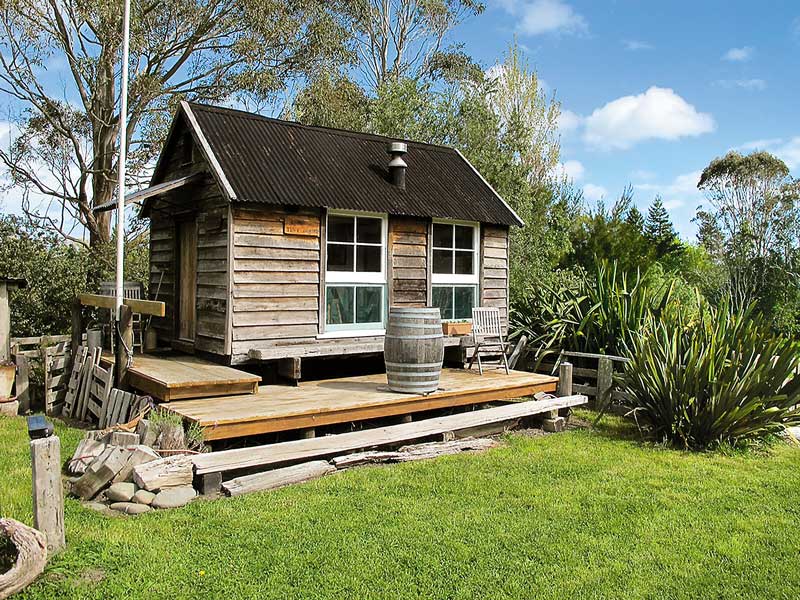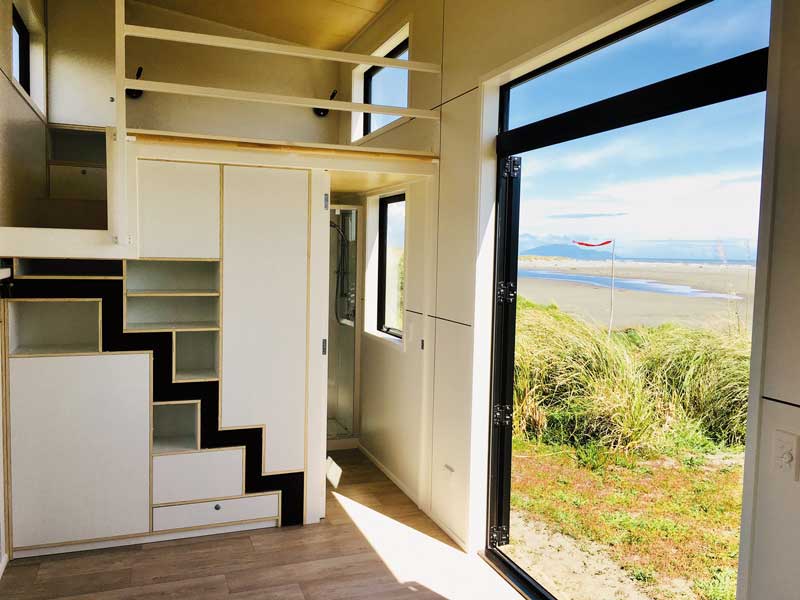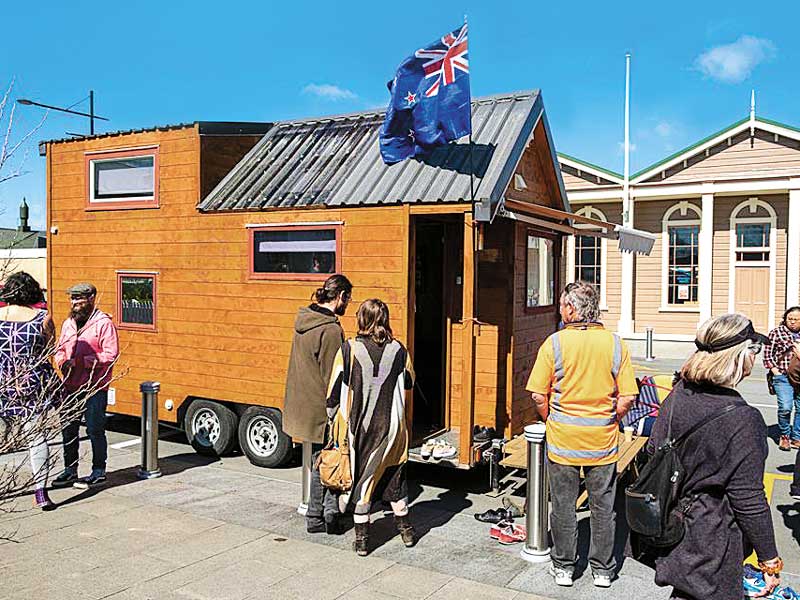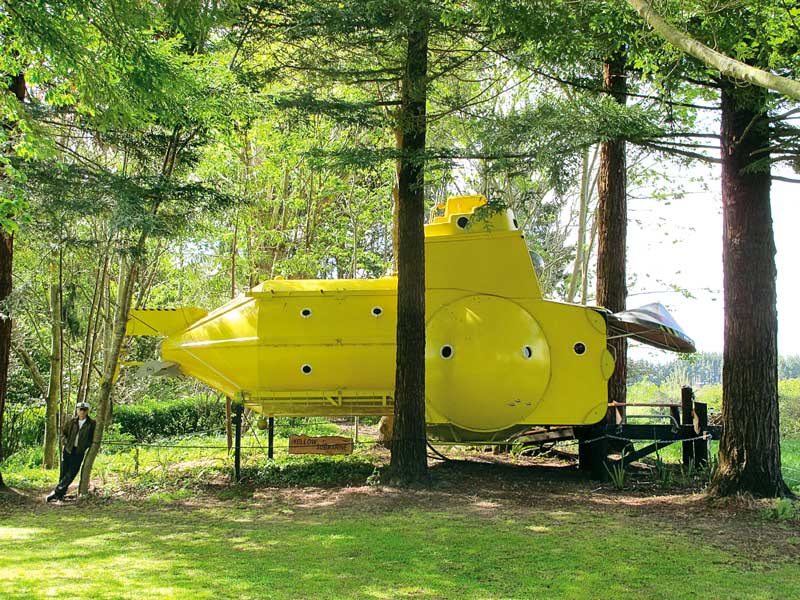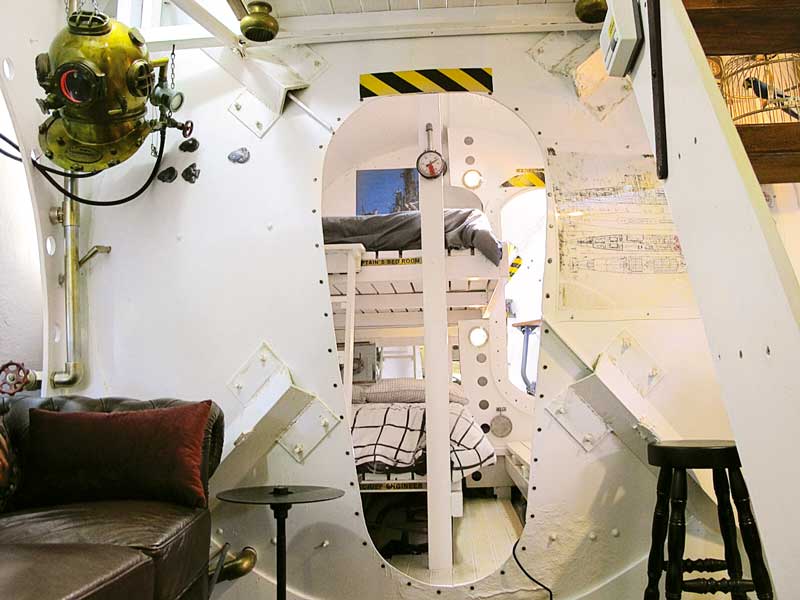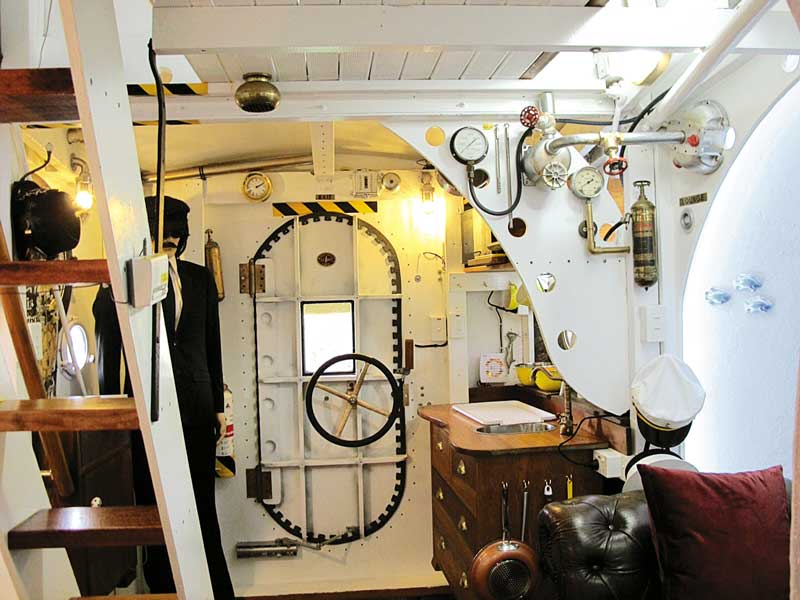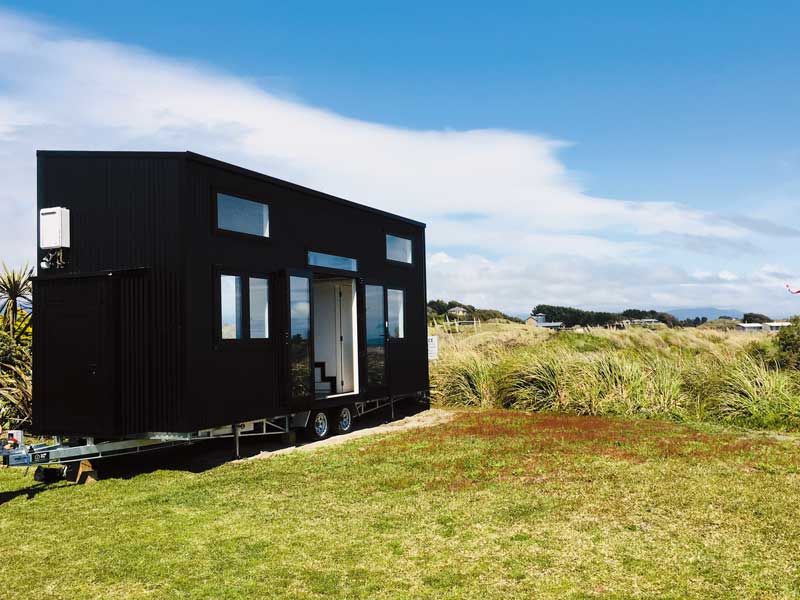If the speakers at this year’s Tiny House and Alternative Living conference are to be believed, your life will only get bigger and better, the more you downsize. New Zealand’s second Tiny House and Alternative Living Conference was held in Carterton on 29 September to a sell-out crowd of 290.
Topics covered at the conference included tiny house building costs, design, and building materials. Speakers shared experiences of finding and renting land and gave tips on solar power and transporting tiny houses safely on the road.
Dare to think outside the box
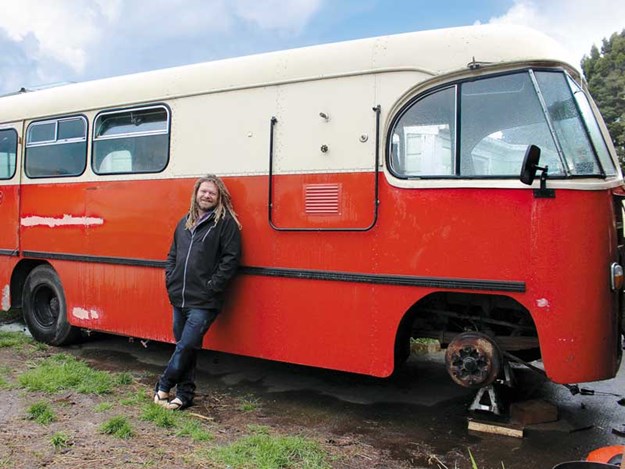 |
Tiny living advocate Philip James outside his current project |
In 2015, Philip James’ doctor told him his desk job as an electrical draughtsman for a global oil company was killing him. So he and his wife Cindy packed up their house in Hamilton, took their two kids out of school, and hit the road in a six-metre-long bus in search of a healthier lifestyle.
“I started this life three years ago. It took me until I was in my 40s to live the life I wanted,” Philip told conference attendees. “If you take anything away from this conference, let it be this: don’t wait until you retire to minimise your life and hit the road. Do it today.
"Don’t wait. Dare to dream. Dare to think outside the box. Make your move to a tiny existence about living a better life,”
Conference organiser Sharla May says, “For me, Philip’s message was probably the main theme of the conference. Building and living in a tiny house is really only part of the story. For most of us, living tiny is about living alternatively and giving yourself permission to not follow the script.”
Sharla’s tiny house story
Sharla, who also spoke at the conference, built her first tiny house in 2016 after selling her standard family home in Whanganui. “I just never felt good in that place. And with all the expenses—the insurance, rates, the personal loan I’d raised to pay for renovations, the utility bills—I found it a grind.”
An advertising sales executive working 10-to-12-hour days, Sharla used the $40,000 profit she made from selling the house to finance the build of a tiny home. Within three months, she’d single-handedly converted a 40-foot refrigerated trailer unit and was signed up to lease land on the Kapiti Coast.
The leasing arrangement turned out to be a disaster, says Sharla, but she learned a lot. Arriving on site, she found the boggy land unsuitable. Then Sharla’s tiny home was damaged by the contractors hired to move it onto the property.
At one point, the landlord demanded $3000 for repairs to the land and threatened to set Sharla’s tiny house on fire.
“The thing to realise with the tiny house movement is that it’s early days in New Zealand. Few of us are doing it. And, for those of us who are, there’s no rule book. We’re all learning as we go. You’ve got to expect a few headaches along the way.
“That’s why I’m organising an annual conference, to share my story, the lessons I’ve learned, and to hear from others too. There’s a lot of expertise within this small, but growing community.”
A wealth of knowledge
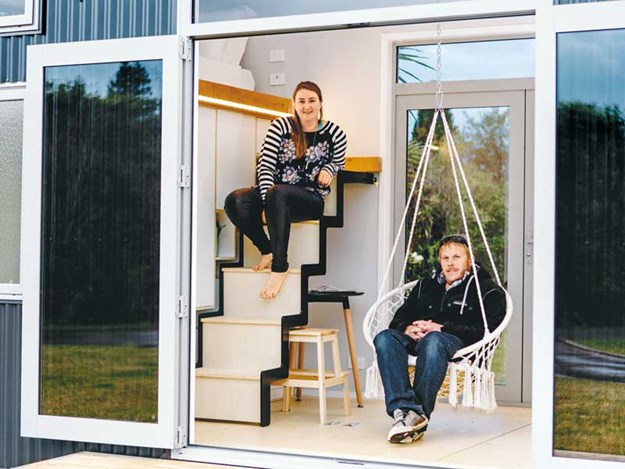 |
Tiny home builders Gina Stevens and Jason Airey of BuildTiny |
All up, there were 15 speakers at the conference, as well as a question and answer panel discussion. Most speakers talked for 20 minutes about their experience building and living in a tiny house.
Interior architect Gina Stevens and brother-in-law Jason Airey, a qualified builder, started out building a tiny house for Gina and ended up launching a business called BuildTiny in Katikati that designs and builds tiny houses. One of their newest tiny houses, a mobile home called TinyVille, was on display at the conference before relocating permanently to the Kapiti Coast as a holiday rental.
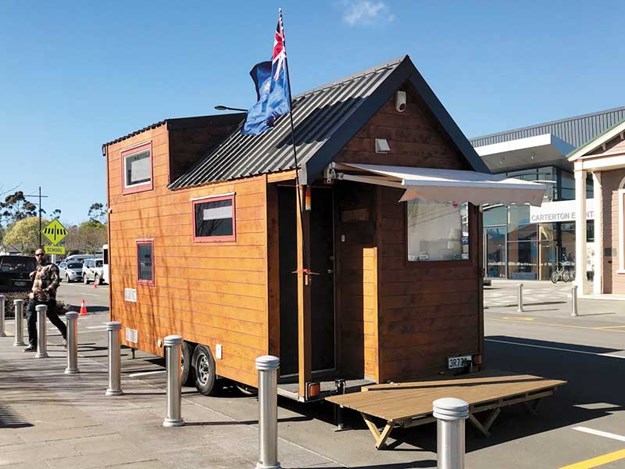 |
Sonny Bai’s tiny wooden home, Lady Jade |
Sonny Bai, originally from North Eastern China, talked about building a tiny wooden home called Lady Jade (also on display at the conference) to give him the freedom to travel his new homeland.
Lucy AitkenRead spoke about constructing yurts in the Coromandel’s Karangahake Valley and living off-grid with her husband Tim and two children. While semi-retired dairy farmer Keith Lovelock described his experience building two themed tiny houses as tourist accommodation on a lifestyle block in Marton.
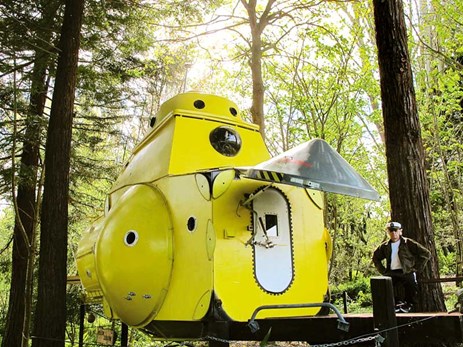 |
Keith Lovelock’s steampunk-themed submarine in Marton, another tiny home available to rent over summer |
One is a colonial-themed house originally intended to be Keith’s den. The other is a steampunk-themed submarine cleverly crafted from an unwanted grain silo and an upturned spa pool.
Fiona’s tiny house story
Fiona Christie, a Carterton local, is building a single-level shepherd’s hut on wheels in a move to become debt-free. Showing me through her tiny home (also on display) during the lunch break, Fiona recounted her story.
“I’m in my 50s. When I realised the mortgage I had on my regular home in Wellington would continue to well after retirement, I figured something needed to change. So I downsized my possessions and started researching tiny houses by travelling around New Zealand. Then I met David, now my partner, and we embarked on the journey together.
With my house sold, I split my time between working in Wellington and building tiny houses in Carterton with David.
“This tiny house is our first go and I love it. You can see David’s wonderful handiwork in the details; he’s a craftsman joiner by trade. The plan is to sell it and build a few more before eventually building a tiny home for ourselves.”
Living off the land
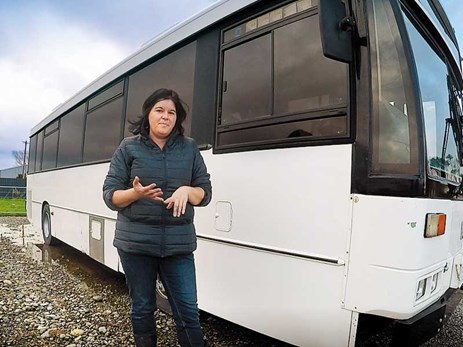 |
Sharla May, conference organiser |
In the meantime, Sharla is living on rented land in Palmerston North as she completes tiny build number two (a $50,000 bus conversion this time).
“At any one time, there can be five groups living independently on the property, including the owners. But it works really well.
“I tell people and they freak out that we’re a religious commune or something. But it’s not like that, though we do call ourselves Gloriavale North! We’re just a small, supportive community who share land and who occasionally get together at wine o’clock.”
For Sharla, what started as a way to minimise her cost of living is now a full-blown lifestyle. She’s no longer sells advertising, but creates websites, runs events and offers business advice instead.
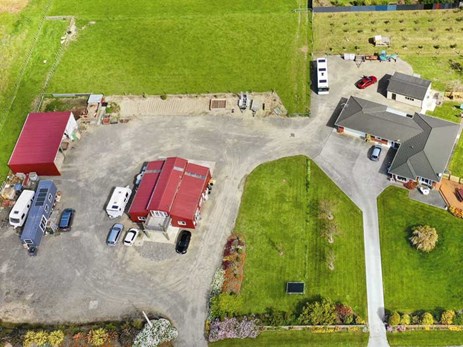 |
‘Gloriavale North’ – a tiny house community in Palmerston North – from the air |
She relies mostly on solar energy, supplemented by a nine-kilo gas bottle that’s refilled every two months. Her biggest weekly expense is the $100 rent bill (which includes unlimited bore water and internet access).
Even getting the groceries is a more positive experience as a tiny house owner. With a food foraging map in hand, Sharla sources seasonal fruit from around the neighbourhood for free or by bartering. She knows exactly where to go to pick organic plums and blackberries.
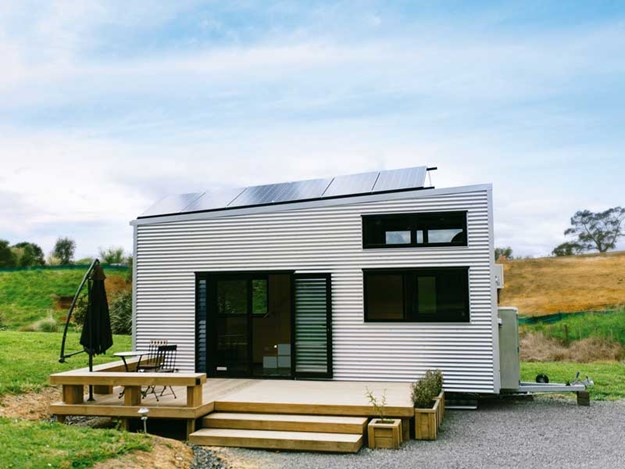
And this summer she’s looking forward to making a special trip to Whanganui to raid a favourite community peach tree.
“I’m definitely a convert to this lifestyle. I’ve reduced my outgoings by more than 70 percent, which is amazing but fairly typical. I still work, of course. But never a 40-hour week. I’ve lost 25 kilos, started a daily walking regime and, since living much more simply, I eat better overall. Truth is, I’ve now got time to enjoy life.”
2019 Tiny House and Alternative Living Conference
Enough time, it turns out, to plan the 2019 Tiny House and Alternative Living conference. Based in Te Puru, New Zealand’s third tiny house conference will be bigger than this year’s, says Sharla, but still focused on networking, sharing stories and providing plenty of practical information.
“As we get bigger, I want to hold on to the original vision of the conference, which was about getting people together who’re genuine about tiny house living. I want it to remain a day for talking to each other and sharing our passion for this lifestyle.
“What does the lifestyle mean to me? I’d say I feel like I’ve found my people. People who understand you don’t have to work to live and without a horrendous mortgage hanging over you, you can live a different but much better life.”
The conference will be back on 27 April 2019. The Te Puru Community Centre will come alive when the conference returns with even more speakers covering tiny house builds, tiny house design, off-grid solar set-ups and what you need to know, living life in a house bus, sharing the realities of living life on the road, minimalism, yurt life, and sustainable living. Find out more at tinyhouseconference.nz
Stay in a tiny house this summer
Tiny house builder Sharla May says: “I tell people it’s fine to watch all those ‘how to build a tiny house’ shows on TV. They’re great. But you’ve really got to step inside a tiny house yourself to know if it’s going to work.”
MARTON
- Stay in Keith Lovelock’s 15m2 Colonial House or Yellow Submarine in Marton.
- Book online at:airbnb.co.nz/rooms/20605023 (Yellow Submarine) airbnb.co.nz/rooms/13646016 (Colonial House)
KAPITI COAST
- Stay in TinyVille at Waikawa Beach on the Kapiti Coast (owned by Shirley and Rodney Inteman).
- Book online at airbnb.co.nz/rooms/28466284 (TinyVille).
BAY OF PLENTY
Stay in BuildTiny’s two 17m2 show homes, the Millennial or Boomer House, in Katikati.
- Book online at buildtiny.co.nz/stay-in-a-tiny-house
How much you’ll pay
Tiny house stays range in price from $109 per night for four people (Keith’s Colonial House, for example) to $135 per night for two people to stay with Shirley and Rodney at TinyVille.

